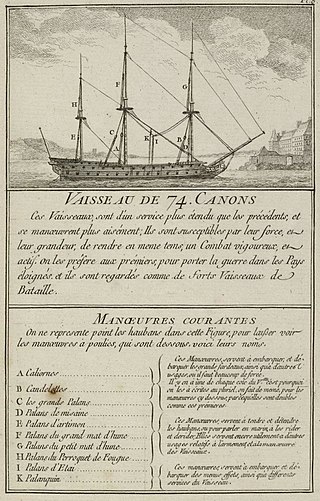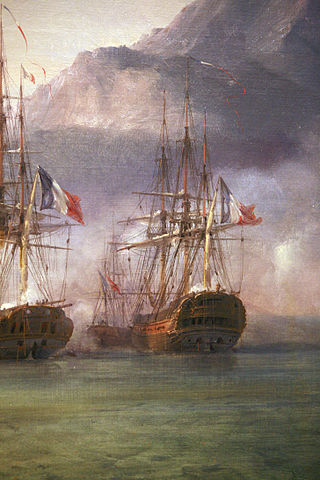
Alexandre Louis Ducrest de Villeneuve [note 1] (Le Theil-de-Bretagne, 7 March 1777 - Paris, 22 March 1852) was a French naval officer and admiral.

Alexandre Louis Ducrest de Villeneuve [note 1] (Le Theil-de-Bretagne, 7 March 1777 - Paris, 22 March 1852) was a French naval officer and admiral.
Ducrest de Villeneuve joined the Navy in 1791, aged 14. In 1796, he was a midshipman first class, and in 1800 he had risen to ensign.
In 1805, he served on Redoutable, under Captain Lucas, and took part in the Battle of Trafalgar, where he was seriously wounded trying to board HMS Victory. Taken prisoner, he was detained on Redoutable, and narrowly escaped drowning when she foundered the next day.
In 1808, Ducrest de Villeneuve have been promoted to lieutenant and was appointed on 26 July to the command of the aviso Mouche n° 6, in Bayonne. Mouche n° 6 was sent in the Indian Ocean for a mission to Ile de France and Manila. [1] [2] Upon his arrival at Manila, he was taken prisoner with his entire crew, as the government had sided for the Allies. He was rescued in early September by the brig Entreprenant, under Pierre Bouvet. [3] Ducrest de Villeneuve later published the journal of his adventures on Mouche n° 6 as Journal du voyage de "la Mouche n°6", sous le commandement du lieutenant de vaisseau Ducrest de Villeneuve, expédiée pour l'Ile de France et Manille, en 1808. [4]
After the action of 17–18 September 1810, in which Vénus and Victor captured HMS Ceylon, Ducrest de Villeneuve was given command of the captured Ceylon. [5] However, the very next day, a British squadron comprising HMS Boadicea, Otter and the brig Staunch encountered the battered ships, and captured them all save for Victor. Ducrest de Villeneuve was taken in captivity.

Released in 1811 and promoted to commander, Ducrest took command of the 44-gun Alcmène, part of a two-frigate squadron under Jean-Léon Émeric who had his flag on the 44-gun Iphigénie. On 16 January 1814, the frigate encountered a British squadron led by the 74-gun HMS Venerable. Iphigénie on her own while Alcmène was caught up and forced into action. Ducrest de Villeneuve was wounded when he brought her alongside Venerable and attempted a boarding. [6]
In 1816, Ducrest de Villeneuve had been released and was in command of the fluyt Normande. [7] He ferried soldiers in the Caribbean to retake possession of the French colonies after the Bourbon Restoration. In 1818, he sailed to Ile Maurice and Ile Bourbon to ferry passengers, notably Bouvet de Lozier. [8]
In 1820, promoted to captain, he commanded the frigate Antigone, which he sailed from Rochefort to Napoli. [9] The next year, on 3 April, he departed from Toulon to patrol off Spain and later Brazil, returning on 11 March 1822. [10]
From 1825, Ducrest de Villeneuve commanded the frigate Astrée and was appointed to the Caribbean station, under Guy-Victor Duperré. [11] In 1826, he took command of the station, relieving vice-amiral Duperré. [12] In August, the squadron sailed from Saint-Pierre et Miquelon to Martinique, returning on 20 December. [13]
In 1829, Ducrest de Villeneuve was promoted to contre-amiral. The next year, he was appointed major général of the fleet in Toulon.
In 1832, Ducrest de Villeneuve was given command of an eleven-ship division that surveilled the coasts of Holland in the aftermath of the Ten Days' Campaign and the Belgian Revolution, with his flag on Médée. [14]
The next year, Ducrest de Villeneuve became préfet maritime of Lorient. He retired in 1842

Redoutable was a Téméraire-class 74-gun ship of the line of the French Navy. She took part in the battles of the French Revolutionary Wars in the Brest squadron, served in the Caribbean in 1803, and duelled with HMS Victory during the Battle of Trafalgar, killing Vice Admiral Horatio Nelson during the action. She sank in the storm that followed the battle.

Diadème was the lead ship of the Diadème-class 74-gun ship of the line of the French Navy.

Jean François Renaudin was a French Navy officer and Rear-Admiral. He is mostly known for captaining the Vengeur du Peuple at the Fourth Battle of Ushant.

Revenant was a 20-gun privateer corvette, launched in 1807, and designed by Robert Surcouf for commerce raiding. The French Navy later requisitioned her and renamed her Iéna, after Napoleon's then-recent victory at the Battle of Jena–Auerstedt. The British captured her in 1808 and she served in the Royal Navy as HMS Victor. The French Navy recaptured her in 1809, taking her back into service under the new name. The British again captured her when they took Isle de France in December 1810. They did not restore her to service, and she was subsequently broken up.

Pierre-François-Henri-Étienne Bouvet de Maisonneuve was a French Navy officer and privateer.

Charles René Magon de Médine was a French contre-amiral killed at the battle of Trafalgar whilst commanding the ship-of-the-line Algésiras - his conduct in the battle is seen by French historians as one of the few redeeming features of that disaster, and his name appears on the Arc de Triomphe. He is also notable as a Grand Officer of the Masonic Grand Orient de France.

The French frigate Iphigénie was a Pallas-class frigate of a nominal 44 guns, launched in 1810. The British captured her in 1814. The British named her HMS Palma, and then renamed her HMS Gloire. She was sold in 1817, never having been commissioned into the Royal Navy.
Marsouin was a gabarre, the name-ship of her three-vessel class, built to a design by Raymond-Antoine Haran, and launched in 1787 or 1788 at Bayonne. She carried troops, supplies, invalids, etc., across the Atlantic to the Caribbean or back until the British captured her in 1795. Though the Royal Navy nominally took her into service, she was never actually commissioned, and she disappeared from the lists in 1799.
Jacques Pinsum was a French Navy officer.
René Lemarant de Kerdaniel was a French naval officer who rose to the rank of admiral.
Entreprenant was a French ship, the third under the same name and with the same captain in the period 1807–1810. She served in the East Indies until the British captured her in 1810 and then had her broken up as unfit for further service.
Jean-Baptiste Henri Barré de Saint-Leu was a French naval officer.
Jean-Baptiste-Augustin Rousseau was a French naval officer.
Jean-Léon Émeric was a French naval officer.

Louis-Charles-Auguste Delamarre, vicomte de Lamellerie was a French Navy officer and nobleman. He is buried in Pere Lachaise cemetery, in Paris.
Jean-Joseph Hubert was a French Navy officer and captain.
Louis Alexis Baudoin was a French Navy officer and captain.
Amand Leduc was a French sailor and Navy officer of the First French Empire.
Goéland was the name ship of a two-vessel class of "brick-avisos", built to a design by Raymond-Antoine Haran and launched in 1787. She served the French Navy for several years carrying dispatches until in 1793 HMS Penelope and HMS Proserpine captured her off Jérémie. The Royal Navy took her into service briefly as Goelan and sold her in 1794. As the merchant brig Brothers she appears to have sailed as a whaling ship in the British southern whale fishery until 1808 or so, and then traded between London and the Brazils. She is no longer listed after 1815.
The Mouche No. 2-class schooner-avisos were a class of twenty-eight 1-gun dispatch or advice boats of the French Navy, all built between 1808 and 1810. Jean Baudry designed the vessels based on the draught of Villaret. Baudry may have been the builder on the schooners launched at Bayonne.